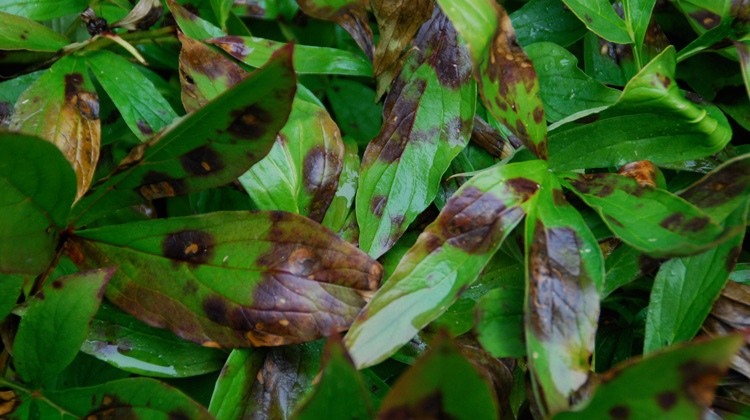Peonies are prized ornamental plants in gardens across North America. Their large, lush blooms in shades of pink red white, and yellow appear in late spring and early summer. However, peony enthusiasts may sometimes notice unwelcome black spots marring the beauty of the leaves.
In this article we’ll explore the common causes of black spots on peony leaves and effective ways to manage the problem.
What Causes Black Spots on Peony Leaves?
There are several possible causes of black spots on peony foliage:
-
Fungal diseases – The main culprits are leaf blotch, gray mold, and phytophthora blight. These fungal diseases thrive in cool, wet conditions.
-
Bacterial infections – Bacterial leaf spot can lead to small black lesions on leaves. High humidity encourages the spread of bacteria.
-
Viral diseases – Peony ringspot virus and tomato ringspot virus cause distinct circular black marks on leaves.
-
Environmental factors – Physical leaf damage from wind, hail, or insects can lead to necrotic black spots Dry soil, poor drainage, or nutritional deficiencies may also be involved.
-
Pest infestations – Insects such as thrips can puncture leaves and leave behind black dot damage.
Preventing Black Spot on Peony Leaves
Prevention is the best medicine when it comes to minimizing black spots on peony foliage. Here are some tips:
-
Select disease-resistant peony cultivars when possible
-
Avoid overhead watering to limit spread of fungal and bacterial diseases
-
Water early in the day so leaves can dry out
-
Promote good air circulation between plants
-
Remove spent flowers and foliage in fall to eliminate disease reservoirs
-
Disinfect garden tools regularly
-
Use preventative fungicidal sprays early in the season if diseases have been a past problem
-
Control insect pests like thrips
-
Maintain optimal soil fertility and pH for strong plant health
Treating Black Spots on Peony Leaves
If black leaf spots occur despite preventive efforts, here are some treatment options:
-
Improve drainage and reduce irrigation if the issue is tied to overly wet conditions
-
Apply neem oil or fungicidal soap sprays to fight fungal/bacterial diseases
-
Remove badly infected leaves or plants to prevent disease spread
-
Apply a balanced organic fertilizer to nourish plants
-
Consider a dormant oil spray just before buds break in spring to smother overwintering pests and diseases
-
As a last resort, dig up and destroy seriously infected peonies
While frustrating, leaf spots caused by fungus, bacteria, or pests do not necessarily kill peonies. The plants can rebound the following season. However, viral diseases signal the infected plant should be removed entirely and destroyed.
When purchasing new peonies, inspect leaves closely for spots and only choose plants with clean, healthy foliage. With vigilant prevention and early treatment, you can continue enjoying gorgeous peony blooms for years to come.
Frequently Asked Questions About Black Spots on Peony Leaves
What does leaf blotch disease on peonies look like?
Leaf blotch fungus causes large reddish-purple spots, up to an inch wide, on peony leaves. Spots may be surrounded by yellowed tissue. Leaves often curl or twist near infected areas.
Can black spots on peony leaves be wiped off?
No, fungal or bacterial leaf spots cannot be wiped off intact leaves. But gently washing leaves with water may help slow disease spread.
Should peony leaves with black spots be removed?
Yes, pruning off infected leaves is recommended to prevent fungal and bacterial diseases from spreading. Discard diseased leaves (do not compost them).
Can peonies recover from black spot disease?
Peonies can sometimes recover after serious black spot infections if the cause is fungal or bacterial rather than viral. Remove diseased tissue, use preventive fungicides, and improve growing conditions.
How do you treat bacterial leaf spot on peonies?
Bacterial leaf spot can be treated with copper-based bactericides or agricultural streptomycin sprayed on leaves. However, prevention with good cultural practices is more effective.
Do peonies get powdery mildew?
Yes, powdery mildew fungus can affect peonies. It coats leaves with white powdery patches and may lead to leaf yellowing and dark spots. Reduce humidity, increase sunlight, and use neem oil spray to manage it.
Peony > Leaves > Spots on leaves 1 of 5
- 1 inch or bigger, uneven to round spots of reddish purple color on the leaves
- Leaf spots that are older have dead tan areas with rough black lines in the middle.
- Leaves may be curled or twisted near the leaf spot
- In the worst cases, leaves fall off but stay attached to the plant.
- Red streaks on stems
- Typically seen mid to late summer, after bloom
2 of 5
Gray Mold Botrytis paeoniae
- When new shoots come up in the spring, they turn black, wilt, and die.
- The leaves and petals have spots that range from black to brown and may turn completely black.
- Stem infections change color to brown or black and often look like a target spot.
- Flower buds turn black to brown and fail to open
- All infected plant parts produce fluffy gray spores with moisture
- Most common in cool, wet weather
- More information on Gray Mold
3 of 5
Peony Leaf Blotch
- The Ultimate Guide to Growing Strawberries in Raised Beds - August 8, 2025
- No-Dig Garden Beds: The Easiest Way to Grow a Beautiful Garden - August 6, 2025
- How to Protect and Preserve Wood for Raised Garden Beds - August 6, 2025

